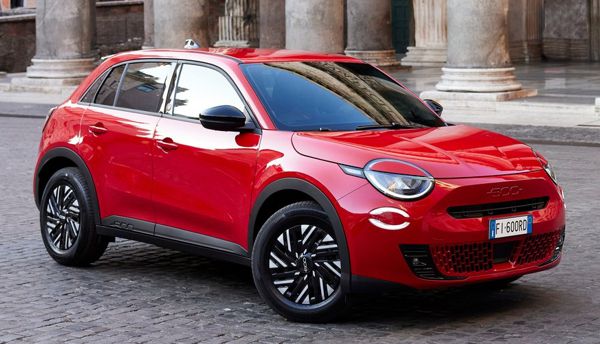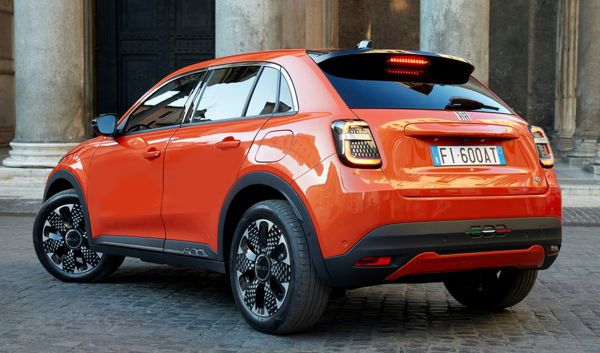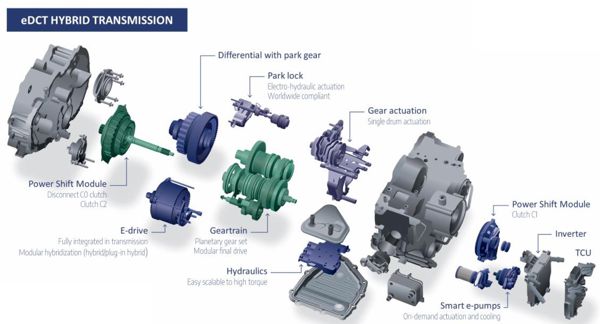Published
on 30
May 2024
|
All rights reserved.
|
|
| 600e |

|
|
Fiat
makes use of Stellantis' e-CMP2 platform to build an electric supermini.
|
|
Sometimes I hesitate to
write about this kind of so-called SUV crossovers. As you know, my
policy is not to promote SUVs, but these days it is not easy to
distinguish SUVs from cars. Clever manufacturers invented something
called “SUV crossover”, which bridges the gap between SUVs and cars.
Then they made the boundary even mushier by shifting SUV crossovers
closer and closer to the territory of cars, to the point that they
think the end products can simply replace their conventional compact
cars. As a result, we have Toyota Aygo X replacing Aygo, Citroen C3 and
DS 3 became crossovers, Ford sent Fiesta to grave and keeps only Puma,
while Nissan did the same to Micra and leaves only Juke. Sooner or
later most of the market’s superminis will be turned into some kind of
crossovers.
On the other hand, rejecting these small crossovers become more and
more pointless because they ARE actually very supermini in essence.
Don’t be fooled by their SUV looks, they are pretty much the same as
superminis underneath their skins: FF layout, simple twist beam
suspension, downsized 3-cylinder engines or even small electric
powertrain. While they are taller than conventional superminis, they
are no longer obviously so, because car makers know they need to cut
drag to return competitive fuel economy and emissions. In fact, most
Japanese K-cars are taller and less wind-cheating than these
supermini-sized crossovers. All these factors drove me to re-consider
not to exclude some eco-friendly small crossovers from AutoZine.
Fiat 600 is one of these cars. While its ride height is higher than
conventional superminis, its 1523 mm height is actually lower than a
Fiat Panda. Its body shell is pretty smooth, too, while the rubber
claddings on wheel arches and skirts do no harm to drag. Moreover,
offering only full-electric or mild-hybrid powertrains, the car has
plenty of green credentials.

|
|
Higher
ride height and rubber claddings aside, it is no different to a
conventional supermini.
|
|
Launched first is the electric version called 600e. While its styling
shares some genes with the lovely 500 Electric, especially its nose and
clamshell bonnet, it is not quite as pretty. To accommodate proper rear
doors and seats, the car is stretched to 4.2 meters, which is the
typical length of a modern supermini. This results in a flatter roof
and a profile less “egg-shaped” than its smaller sibling. Inside, the
600’s oval dashboard is again reminiscent of the 500 Electric, but it
lacks the latter’s choice of customization.
In fact, the 600e is not derived from the 500 but the much higher
volume CMP platform of Stellantis group. More specifically, it is
e-CMP2, in which e denotes its electric propulsion and 2 distinguishes
it from the first generation. Key progress is enlarging the battery
from 50 to 54kWh (gross) and upgrading the front-mounted electric motor
from 136 to 156 hp. It goes without saying these specifications are
just the same as other platform-mates such as Peugeot e-208, e-308,
Opel Corsa-e, Astra Electric, DS 3 and Jeep Avenger. In particular, the
Jeep Avenger is the closest to the Fiat because they are built together
in Poland, sharing a lot of parts underneath the skin.
The e-CMP2 is not exactly a skateboard platform. Its battery modules
are stacked under the front and rear seats, leaving space for foot
wells. As the floorpan that contains the battery casing is a common
design, it does not allow stretching wheelbase or relocating seats
easily, unlike a skateboard platform. While rear passengers don’t need
to have their knees raised, there is no space underneath the front
seats to place their feet. A common problem of all Stellantis’ e-CMP
cars is cramped rear legroom, and this remains true to the Fiat 600e,
unfortunately.
Space up front is better. Otherwise, the 600’s cabin is a typical
supermini. It is not as premium-feeling as the electric 500 because a
lot of switchgears and structural parts are shared with Jeep. Ditto the
same touchscreen infotainment system which is fine to use but the user
interface is not the most intuitive.

|
|
A
common problem of all Stellantis’ e-CMP cars is cramped rear legroom,
and this remains true to the Fiat 600e.
|
|
At 1520 kg, the 600e is pretty light for an electric car. However, 156
horsepower is not a lot for a 1.5-ton car, so its performance is just
okay. 0-60 mph is accomplished in the mid-8 seconds range, while top
speed is restricted to 93 mph. Use it as an urban car and it feels more
energetic, as the electric torque is most obvious below 50 mph. As you
travel faster, the sense of thrust fades away in typical EV fashion.
However, by class standard its performance is still a little below
average.
The same goes for its chassis. It works perfectly fine as a city car,
thanks to very light steering and a soft-setting suspension. The ride
is supple, absorbing bumps and potholes in town easily, but the
flipside is pronounced body roll if you push it into corner. The light
and lifeless steering aids no confidence either. The stability control
intervenes early. The brake pedal feels abrupt. There is not much
excitement to have in terms of driving. Meanwhile, the 600e also
suffers from lack of high-speed refinement, as wind and tire noises
could be intrusive on highway. Better to keep it inner city.
Without adjustable regenerative braking, single-pedal driving is out of
question. However, the 600e is still quite efficient to run, thanks
partly to standard heat pump. WLTP range is 252 miles, putting the
Chinese-built Mini Cooper E (190 miles from 54kWh battery) in shade.
Its 100kW quick charging is also competitive among small EVs.
The trouble is, there are plenty of choices on the market. Some offers
more performance and range at similar money, while the Stellantis group
itself also provide plenty of choices with the same specifications but
different packaging. Whether the 600e can stand out is very
questionable. It lacks the flair of traditional Italian small cars, not
just styling but also the way it steers.
|
Verdict:    |
Published
on 30
May 2024
|
All rights reserved.
|
|
600 Hybrid
|
|

|
|
Mild
hybrid version of 600 is cleaner than most rivals.
|
|
Sales of EVs are
struggling. Some car makers have already backed off from their original
plans of shifting to all-electric line-up from 2035 or even 2030. They
have restarted development work on ICE models, but that will take time.
Things are easier at Stellantis, because most of its platforms are
designed to allow electric or ICE power. On the downside, it might not
be the most efficient to use space and mass. On the plus side, it
allows the group to react promptly to changing market demands,
introducing new ICE or EV models easily.
Even before the slum of EV market, Fiat had already decided to add an
ICE version to the 600 to broaden its customer base. This model is
called 600 Hybrid, although it is actually a mild hybrid, a trick used
by also the ICE version of Fiat 500. However, the mild hybrid design
used here is quite special. While most car makers employ a 48V
integrated starter generator (ISG) to provide assistance in
acceleration, the Stellantis system has its electric motor incorporated
into a 6-speed dual-clutch gearbox. In fact, this so-called eDCT was
developed by Belgian-Dutch transmission expert Punch Powertrain, then
Stellantis formed a joint-venture with it to produce the eDCT at two of
its plants, Metz, France, and Mirafiori, Italy. It goes without saying
Mirafiori supplies the 600e. With a combined capacity of 1.2 million
units a year, expect many Stellantis group cars will be hybridized very
soon.

|
|
eDCT
was developed by Punch Powertrain and built by the JV with Stellantis.
|
|
The electric motor in eDCT produces 29 horsepower, more powerful than
the rivaling ISG solution – for example, Mercedes’ EQ power offers 22
hp. It is paired with a small 48V lithium-ion battery. The mild-hybrid
system works at lower speeds to assist acceleration, but it may work
solely by itself at up to 30km/h (19 mph) or when the car is coasting
on highway with engine turned off momentarily. Naturally, it works most
efficiently in urban driving where frequent deceleration can recharge
the battery, in that scenario Stellantis claims a fuel saving of 15
percent.
Predictably, the combustion part of the powertrain is the group’s
1.2-liter 3-cylinder direct injection turbo. In this case it is
configured to run at Miller cycle by delaying the closure of intake
valves, so to achieve longer expansion stroke and higher thermal
efficiency. Because the effective engine capacity is reduced, this
engine produces only 100 horsepower.
The end results? The 600 Hybrid is slower than 600e, of course. It
takes more than 10 seconds to go from rest to 60 mph, but the petrol
motor can sustain acceleration until 114 mph, 21 mph higher than its
electric sibling. Without battery intruding the boot, its luggage space
is 25 liters more. It is also 250 kg lighter than the 600e, hopefully
benefitting handling. CO2 emission of 110-114g/km is lower than all but
a few full-hybrid rivals. Best of all, the petrol model is 30 percent
cheaper to buy than the 600e, putting Fiat back to the game of
conventional supermini segment.
|
Verdict:    |
Published
on 14
Jan 2025
|
All rights reserved.
|
|
Abarth 600e
|
|

|
|
Stellantis
applies the same know-how of Alfa Junior Veloce to Abarth...
|
|
Starting from Alfa Romeo
Junior Veloce, you can see Stellantis has finally cracked the codes and
unlocked the potential of EV hot hatches. The baby Alfa will not be the
only one though, as Stellantis will undoubtedly spread the same
know-how to its many other brands. In fact, two of which have already
been unveiled: Abarth 600e and Lancia Ypsilon HF.
The Abarth 600e is as different to its donor car Fiat 600e as Veloce to
the lesser Alfa Junior. It keeps the standard car’s 54kWh battery,
front-wheel drive and torsion-beam rear axle format, hence a relatively
low kerb weight at just over 1.6 ton. The front-mounted motor is
upgraded to 240 horsepower, accompanied with 254 pound-foot of torque.
That’s for the standard model called Turismo. A hotter model called
Scorpionissima adds another 40 horsepower but no more torque, which is
exactly the same tune as its Alfa sibling. Like the Alfa as well, both
Abarth models employ a Torsen LSD as standard, allowing them to put
down the power cleanly and enhance cornering traction. Top speed is
limited to 124 mph in both cases, while 0-60 mph takes 5.9 or 5.6
seconds. They are not as crazy as some Chinese EVs, but quick enough to
match conventional hot hatches.
Unlike its Chinese rivals, the Abarth gets proper chassis upgrade to
match the enhanced performance. Front and rear tracks have been widened
by 30 and 25 mm, respectively. Suspension is lowered by 25 mm, along
with stiffer anti-roll bars and retuned dampers. Brakes are upgraded as
well, particularly the front which gets 380 mm discs and 4-piston
calipers. Wheels are 20-inch items and shod with Michelin Pilot Sport
EV tires. Most of these components are shared with the Alfa.

|
|
You
can drive the Abarth very hard in the twisty as in a conventional hot
hatch, but the balance is not quite as adjustable as Alfa.
|
|
What the Abarth cannot match the Alfa is style. As hard as its
designers worked, they cannot overcome the dull template set by the
standard 600e. It looks a bit too tall and bulky. The straight
waistline fails to deliver a sense of dynamics. Inside, new bucket
seats, Alcantara-wrapped steering wheel and alloy pedals distinguish it
from lesser Fiat, but overall the environment still looks quite
ordinary. The driving position is a tad too high, while rear legroom is
just as tight as any Stellantis e-CMP2 cars.
On the road, the Turismo model feels a brisk to drive. Its acceleration
is not EV-silly, but the power delivery is linear and the turn of
acceleration is comparable to conventional hot hatches. The 280 hp
model doesn’t feel a lot quicker, so unless you must have the Sabelt
buckets or artificial sound generator exclusive to it, it is perfectly
okay to stick with the cheaper Turismo. (Abarth knows that as well, so
it limits the production of Scorpionissima to 1949 cars.)
As in Alfa, the LSD works extremely well to contain wheel spin and
enhance traction, allowing you to get on throttle earlier and harder in
corners. The grip those Michelin EV tires produce is respectable. You
can drive the Abarth very hard in the twisty as in a conventional hot
hatch. However, the balance is not quite as adjustable by throttle as
Alfa. There is a bit more understeer at the limit, and lift-off
oversteer is very limited. There is no regen in sportier mode, but the
brake pedal calibration is not ideal, as it lacks initial bite in hard
driving. Overall, its Alfa Romeo sibling has an edge in driving
engagement, although the Abarth is undoubtedly just as quick in the
twisty.
When you drive leisurely, the Abarth 600e is perfectly livable. The
suspension, while firm, is comfortable enough for daily commute. The
steering becomes usefully light at city speed. Road noise is ever
present though. Its biggest weakness is driving range, i.e. limited to
around 200 miles by the relatively small battery. For comparison a VW
ID.3 GTX can travel 369 miles with its 79kWh battery, although it is
also considerably more expensive to buy. Drive as hard as the Abarth is
supposed to be, real-world range could be marginal.
|
Verdict:    |
|